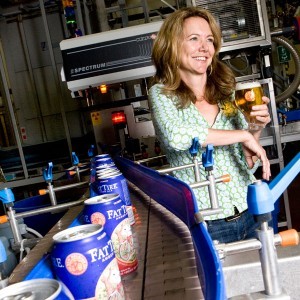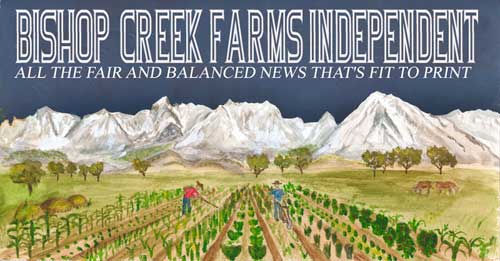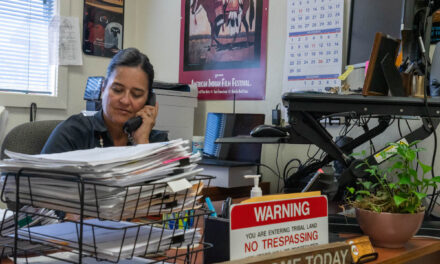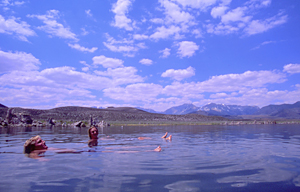- Tahoe’s Nevada Beach Tops the List of Hard-to-Book Campgrounds - 07/17/2024
- Cannabis Watershed Protection Program Cleans Up Illegal Grow Sites - 07/10/2024
- French Fire - 07/05/2024
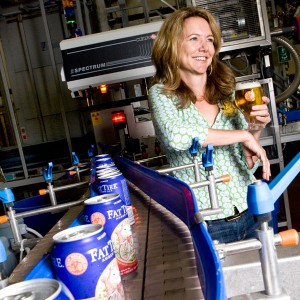
Kim Jordan, co-founder and president of New Belgium, watches cans come off the line. New Belgium validated the trend when it released its Fat Tire Amber Ale in cans in 2008. Photo courtesy of New Belgium Brewing

Kim Jordan, co-founder and president of New Belgium, watches cans come off the line. New Belgium validated the trend when it released its Fat Tire Amber Ale in cans in 2008. Photo courtesy of New Belgium Brewing
From Colorado to San Francisco, Mammoth to Boonville, and soon Chico, craft breweries big and small are joining the canned beer revolution. Portability is just one reason.
By Derrick Peterman and Pete Gauvin
Something new is showing up in backpacks, in mountain streams, on rafts, and even on the beach. It’s beer in cans brewed by local and regional craft breweries.
The great outdoors is often enjoyed with beer in a can, since cans are lighter than bottles, shattered glass is not a hazard, and empties can be crushed for easy transport out of the woods. Moreover, bottles are often prohibited at many outdoor locations. Plus, canned beer submerged in a cold mountain stream cools down much faster than bottles.
So craft beer in cans is good news for outdoor enthusiasts, an independent-minded crowd that generally appreciates quality local and regional brews with character over the mass-market swill from corporate breweries that sink more of their budgets into advertising than their product.
Craft brewers themselves are also enthusiastic about cans. Check out their websites and you’ll find plenty of feel-good statements about how cans are better for both the beer and the environment. Cans protect beer from oxygen and sunlight better than bottles, and are a more earth-friendly package because they are significantly lighter than glass (35% of the weight of a bottle of beer is the bottle itself), stack easily with less packaging, require less energy to transport, and are more efficiently recycled.
“I absolutely love the package. They’re like mini-kegs,“ gushes Sean Turner, owner of Mammoth Brewing Company in the resort town of Mammoth Lakes.
The Eastern Sierra brewery, founded in 1995, started selling beer in cans four years ago, one of the first craft breweries to do so.
“Everything out here is so outdoor oriented. We sell beer in cans to hikers, fishermen, boaters, and golfers,” says Turner, whose brewery cans three of its brews to satisfy a wide range of taste buds: Epic IPA, Golden Trout Pilsner, and Real McCoy Amber Ale.
North of San Francisco in Mendocino County there’s a similar new-found enthusiasm for aluminum pop-tops at Anderson Valley Brewing Company in Boonville. Brewmaster Fal Allen is encouraged by the new sales growth spurred by last year’s decision to release three of Anderson Valley’s more popular beers in cans: Boont Amber, Hop Ottin’ IPA and Summer Solstice Cerveza Crema.
“Canned beer is about 8% of our business and growing fast,” says Allen. “It used to be our canning line would run once or twice a week. Now it runs pretty much every day.”
While it turned out to be a good business decision, Anderson Valley Brewing, which generates 40% of its electricity from solar panels atop its brewery, was also highly motivated by the environmental benefits of cans. Cans are nearly 40% lighter to ship than bottles, greatly reducing fuel costs and their carbon footprint.
It’s been less than 10 years since Colorado’s Oskar Blues Brewery became the first U.S. craft brewery to can its product when it started hand-canning its Dale’s Pale Ale in 2002 — a hoppy, strong (6.5% ABV) and critically- acclaimed brew that no doubt shocked a few unsuspecting palates weaned on limp, watered-down, mass-market lagers.
Today, there are 117 craft breweries in the U.S. offering premium beer in cans, according to the Canned Beer Database at CraftCans. com. And more are hopping on the can wagon every month.
The First Canned-Beer Revolution
Of course, canned beer has been around for decades. The first canned beer was sold in 1935 by the Krueger Brewing Company of New Jersey, which canned Krueger’s Cream Ale and Krueger’s Finest Beer for distribution in the mid-Atlantic and Northeast.
By the end of 1935, 36 breweries were using cans — which, interestingly, included Pabst Brewing, whose “PBR” in recent years has established itself as the unofficial value beer among the outdoor set.
The first cans were made from heavy- gauge steel. Aluminum cans didn’t debut until 1958.
Sounds pretty good. But such regional breweries like Krueger’s (sold in 1961) wouldn’t last in the face of competition from national breweries like Schlitz and Anheuser- Busch.
In following decades, corporate breweries with high-speed canning machines began to dominate the American beer market. Creativity, quality and distinctiveness suffered in the battle for market share and profits. In most cases, the resulting product from these corporate breweries was a thin, fizzy, watery brew with a slightly metallic taste.
As tastes evolved with the resurgence of American craft breweries in the ‘80s and ‘90s, canned beer was derided by beer enthusiasts as cheap, tasteless and decidedly low-brow. But for cans, it was guilt by association. They were unfairly judged for the character of their contents, rather than the quality of the container. And such perceptions die hard.
Indeed, for the craft-brewing community devoted to flavorful hand-crafted beers brewed in small batches, canned beer epitomized everything that was wrong with American brewing. Even when an inert water-based lining for aluminum cans was developed in the 1980s to help protect the contents from ever touching metal, canned beer could not shed its cheap and inferior reputation. The stigma persisted and was only enhanced as “micro-brewed beer” became widely available, all in bottles, initially.
Clearing the Bottleneck
So how did canned beer mature to become the new darling of craft brewers?
The unlikely transition was spurred by a micro brewery in Canada’s Yukon Territory and a small Canadian manufacturing company which stumbled onto canning beer like a bear on a backcountry campsite.
Virtually all beer in cans sold by craft breweries in North America is canned by equipment manufactured by Cask Brewing Systems out of Calgary. The company got its start selling on-premise brewing systems to small brew-it-yourself operations that allowed home brewers to come in and use the facilities to brew their own beer.
Problem was, these brewing hobbyists often poured their beer into used and poorly cleaned bottles, with the beer degrading quickly thereafter. So in 1999, Cask developed a simple manual canning system so all that homebrew didn’t get poured down the drain.
Shortly thereafter, the owners of Yukon Brewing, a craft brewery in Whitehorse, Yukon’s capital and largest city (pop. 20,500) … a brewery “conceived like many Yukon babies — around a campfire on a canoe trip” … recognized that about 60% of beer in the Yukon was sold in cans and wondered how they might be able to squeeze into that market.
As they looked around for canning equipment, everything they found was for large scale brewing operations dealing with far greater volumes than they could possibly brew and priced far higher than they could afford. Then they tripped upon Cask Brewing’s manual canning equipment and gave them a call.
“That’s when all the light bulbs went on around here,” recalls Jamie Gordon, a technical sales rep for Cask who’s been with the company for over 25 years.
In 2001, Yukon Brewing bought Cask’s manual canning system and became the first North American small-scale brewery to sell beer in cans.
Seeing a market for small canning systems for the hundreds of small breweries then in existence, Cask Brewing Systems decided to market their system at the 2002 Craft Brewing Conference in Cleveland, hoping to make a big splash.
The response went over like warm beer on a summer day.
“Everyone looked at us like we were crazy,” remembers Gordon, as negative perceptions of canned beer remained high. “One guy walked up, shook his head, and told us it was the stupidest thing he’d ever seen
… I’d like to know where that guy is now.”
As the saying goes, all it takes is one — and others will follow. Perhaps no one knows this better than beer drinkers.
In this case, Oskar Blues from tiny Lyons, Colo., was looking for a way to distinguish itself from the numerous craft breweries dotting the Rocky Mountain landscape like 14,000-foot peaks, and was willing to make the leap.
“We thought the idea of our big, luscious pale ale in a can was hilarious,” recalls founder Dale Katechis on the Oskar Blues website. “And it made our beer immensely portable for outdoor enjoyment.”
Only later would he and his crew discover the benefits of cans — such as better beer preservation, a lighter environmental footprint and lower shipping costs.
Already a successful brewpub, Oskar Blues was mainly looking for a way to sell some extra beer. But so many campers bought Dale’s Pale Ale on their way to nearby Rocky Mountain National Park they soon automated their canning system to keep up with the unexpected demand.
Colorado’s dynamic craft brewing scene couldn’t help notice Oskar Blues’ success.
The market for canned beer for the active, outdoor-oriented consumer was no longer a secret. Coors Light wasn’t going to be the first option any more.
Fermenting Acceptance
Yet negative perceptions of canned beer continued to be hard to settle, even as more and more small breweries started selling beer in cans.
In 2005 when San Francisco’s 21st Amendment Brewery decided to start selling beer to take home from their brewpub, Shaun O’Sullivan suggested to co-founder Nico Freccia to package it in cans.
“It seemed like the stupidest thing I ever heard of,” remembers Freccia, “until Shaun started explaining all the benefits of canning, and then it seemed like a no-brainer.”
Another regional brewery that rolled straight into cans is Reno’s Buckbean Brewing Company, started in 2008, which cans its Black Noddy Lager, Orange Blossom Ale and Tule Duck Red Ale.
Things really started to change when the major craft breweries got into the canning act.
In 2008, New Belgium Brewing released their nationally popular Fat Tire Amber Ale in cans. “Fat Tire in a can really validated everything we were doing,” says Mammoth Brewing’s Turner.
“The negative perceptions are no longer an issue,” agrees 21st Amendment’s Freccia.
And if that validation isn’t enough to pop your bottle cap, word comes down the canning line that the most prominent and influential craft brewery in California, if not the nation, Sierra Nevada Brewing Company of Chico, plans to release its iconic Pale Ale and Torpedo India Pale Ale in cans by the end of the year.
“The number one reason we decided to do this was cans go where bottles can’t, especially on hiking trails, rafting, and other places people want to take them outdoors,” explains Bill Manley, Sierra Nevada’s spokesperson. “I’m really excited our beers are coming out in cans this year.”
One of the reasons Sierra Nevada — which founder Ken Grossman named after his favorite hiking destination — hasn’t joined the canned beer frenzy sooner is that they’ve been searching for a plastic lining for their cans that won’t absorb hop compounds over time, says Manley, which they believe they’ve now found.
For “malt forward” beers such as Fat Tire Amber Ale, which generates most of its flavor from roasted malts, absorption of hop compounds has little consequence. For Sierra Nevada’s Pale Ale and Torpedo IPA, with their distinctive hop flavors and aromas, preservation of the beer’s hop character is more essential.
Though it is now the sixth largest brewing company of any stripe in the U.S., Sierra Nevada remains an environmentally conscious, independently owned business. The brewery is powered by solar energy, operates its own water treatment plant, and is the largest buyer of organic hops in the U.S. For these reasons and others, it won the U.S. Environmental Protection Agency’s “Green Business of the Year” award in 2010.
But it wasn’t going to jump into the canned beer fray just because cans are an arguably greener option without first assuring that its first priority, the quality of its beer, would not be compromised.
Just as with bottles, craft brewers realize that canned beers are only as good as the beer inside. The last thing they want is someone carrying a couple cans 10 miles into the backcountry only to be disappointed. For one, that person could be Ken Grossman.
Secondly, how far behind can freeze-dried beer be? Just tear open the foil pouch and add water. Suddenly hiking the PCT for weeks on end would appeal to a much wider audience, I’m guessing. Or perhaps not.
For the foreseeable future, though, it appears craft brewers will no longer be kicking the can down the road.
_______________________________________________________________
Derrick Peterman is a runner and craft-beer enthusiast in the Bay Area. You can read more of his writing on his blog, “Ramblings of a Beer Runner,” (beer-runner.blogspot.com), where he explores the not-so-obvious parallels between running and beer, as well as the occasional enjoyable intersection.

